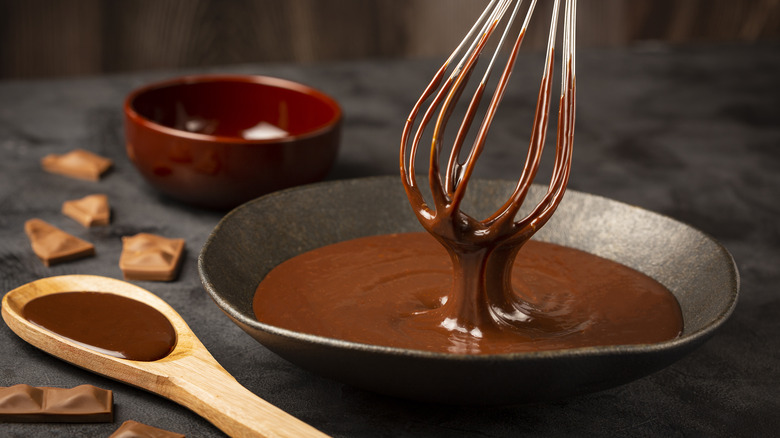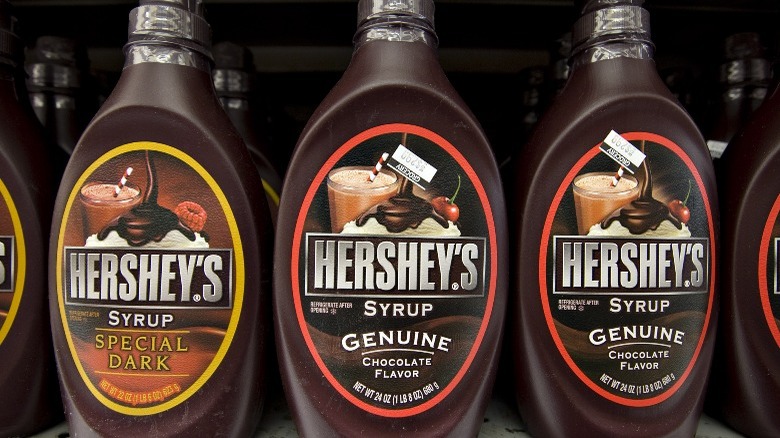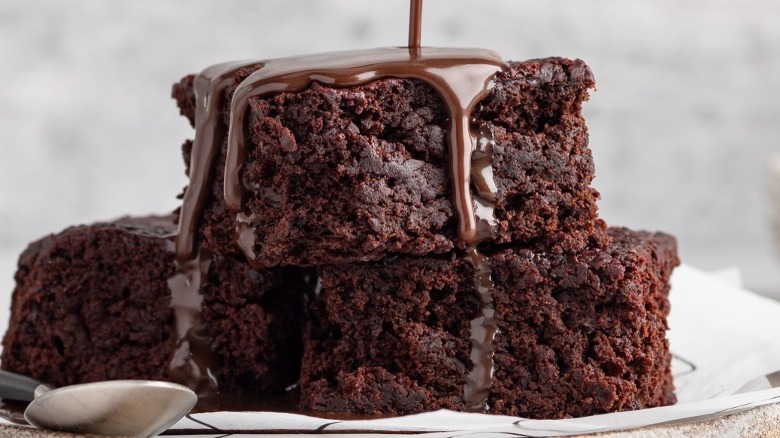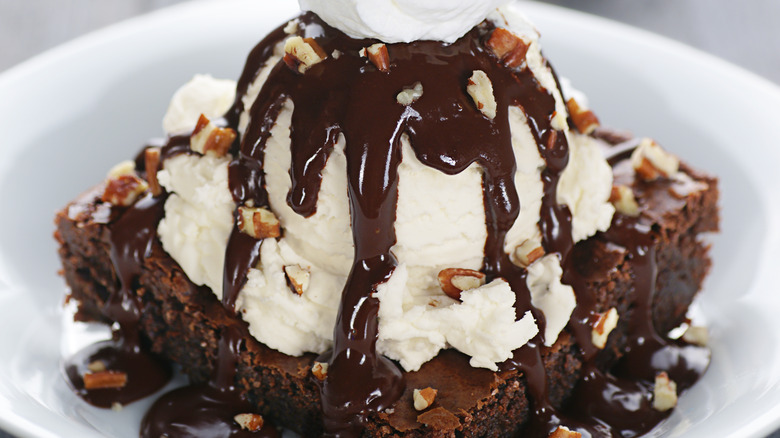The Difference Between Chocolate Sauce, Chocolate Syrup, And Hot Fudge
If you're confused about the differences between hot fudge, chocolate sauce, and chocolate syrup, you're not alone. Clearly, they all have a lot in common, from their appearance to their uses, and whether smothered over an ice cream sundae, drizzled on bread pudding, or stirred in to chocolate milk, all three have the ability to elevate a dessert to new heights. Understanding their differences can help you decide which one to use, depending on the situation.
In the simplest terms, it all comes down to viscosity — hot fudge is thicker than both chocolate sauce and chocolate syrup, with a richer, more decadent chocolate flavor. In contrast, chocolate sauce is thinner, has a slightly less luxuriant mouthfeel, and is a touch sweeter, and chocolate syrup is the thinnest and sweetest of all. Hot fudge often uses better-quality chocolate and richer ingredients for a deeper flavor profile and a more intensely chocolatey experience that lingers on the tongue longer. And although chocolate sauce and syrup (though they're not the same thing) are not as complex as hot fudge, their lower viscosity allows them to pour easier, topping dishes without weighing them down.
Chocolate syrup is the thinnest of the three
Chocolate syrup is the stuff childhood is made of — sweet, chocolatey, inexpensive, and, best of all for parents — self-serve. It's an easy mix-in for milk (both cold and hot), and is also great drizzled-over ice cream, pancakes, waffles, French toast, and even oatmeal. It can even be a perfect dip for fruits like berries, pears, and apples. And while it's easy to pick up just about anywhere, chocolate syrup is super simple to make at home, requiring only sugar, cocoa, and water.
On the viscosity front, chocolate syrup is pretty thin and liquidy, but that's what makes it so easy to turn milk chocolatey and add a little sugary chocolate buzz to almost anything without it feeling too heavy or too rich. That also means the flavor notes here are simple, sugar-first, and chocolate second without a lot of complexity, but that's to be expected, considering it doesn't have any fatty ingredients to help those flavors linger — not so of our next pair of entrants.
Chocolate sauce is the sweet happy medium
Texturally, chocolate sauce is a bridge, fitting nicely on a spectrum between chocolate syrup and hot fudge with a viscosity somewhere between the two. And while the terms chocolate sauce and chocolate syrup are often used interchangeably, they are not to be confused. It's true both syrup and sauce are sugar-forward, with the chocolate playing a bit more of a background role compared to hot fudge, but chocolate sauce is still thicker and richer than its "syrupy" counterpart.
In fact, if you want to change your chocolate syrup recipe to chocolate sauce, it's an easy swap. Just substitute milk or cream in place of water and you'll have a basic chocolate sauce. The addition of these creamy liquids provides a thickness and body to the sauce that allows the chocolate flavor to cling more to the foods it's draped on and to your tastebuds as well, allowing you to savor the chocolatey flavor longer. Salt, vanilla, and even a splash of coffee can add a bit of dimension here.
And although chocolate syrup is often the go-to choice for chocolate milk, chocolate milkshakes, and hot chocolate, a thin chocolate sauce can work just as well, especially if you want a deeper chocolate flavor and extra creaminess in your drink. Chocolate sauce's elevated richness make it excellent for drizzling over desserts of all sorts — cakes, brownies, profiteroles, baked puddings, and of course, ice cream.
Hot fudge is the thickest and richest
Hot fudge is the thickest and heaviest of the three, also consisting of cocoa and sugar. It's the addition of heavy cream (in place of water or milk) and butter that creates hot fudge. Cream and butter give hot fudge its lush texture, flavor complexity, and dense richness. In addition to cocoa, chunks of chocolate are sometimes added for even more chocolatey goodness. And though it can also be dolloped or dripped on any dessert you'd like to add a fudgy flourish to, hot fudge sundaes are its most well-known use. And for good reason, nothing beats the hot-cold contrast a sundae brings — the way hot fudge clings pudding-like onto sweet vanilla bean ice cream — nothing else compares.
All three options, syrup, sauce, and hot fudge can easily be made in a saucepan at home over medium heat, slowly whisking the ingredients until thoroughly combined and heated through. In the case of hot fudge, the butter is added last to help your fudge sauce reach the ideal texture and smoothness. Allow time for cooling afterward as this aids these sauces in their thickening. Although it may be tempting to make extra for later use, it's never a good idea to can homemade chocolate sauces. Instead, freeze them in a freezer-safe container.
Now that you've got the scoop on the differences between chocolate sauce, chocolate syrup, and hot fudge, you can tailor your next treat for optimum chocolate bliss.



